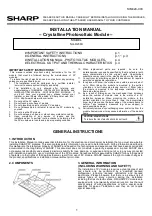
SIM424-003
4
INSTALLATION MANUAL -PHOTOVOLTAIC MODULES-
NQ-R258H
1. INSTALLATION
The mounting method has been verified by SHARP and NOT
CERTIFIED by a third party organization. Please review the
descriptions and drawings carefully; not mounting the modules
according to one of these methods may void your guaranty.
These mounting methods are basically designed to allow
module loading of
±
2400Pa.
Mounting Using Clips:
Clamping on Longer Frame (Figure1)/ Shorter Frame (Figure2)
The modules can be mounted using clips (clamps)
designed for solar modules as defined in the following
Figures. Note that the mounting clips should meet the
required dimensions as defined in respective Figures. Note
that the CLIP CENTER POSITIONS (L,S) are important as
specified in respective Figures. The module must be
supported on the array system and should overlap the array
rail by at least 10mm. The array rails (see pointillist image,
row or vertical row) must support the bottom of the frames
and must be continuous piece (no breaks in the rail).
2. ELECTRICAL INSTALLATION INSTRUCTION
CABLE requirement
Conductor size: 4.0mm
2
,
Cable type: XLPE cable (H1Z2Z2-K cable )
Maximum DC voltage: 1.8kV
Ambient temperature: -40°C to +90°C,
Maximum conductor temperature: 120 °C
Module configuration (Recommend)
# Maximum series configuration: please refer to Table-1
(This value is calculated under the condition of Voc at -40 °C.)
# Maximum parallel configuration: (Parallel connection of each
string shall be conducted with following two options. Any other
parallel connections are prohibited.)
a) Case of using the diodes; 1 diode per maximum 2 parallel
strings (Connect a diode or more in series for every string or
every 2 parallel strings for protection of module from reverse
current over load.)
b) Case of using the fuses; 1 fuse per every string (Connect a
fuse for every single string for protection of module from
reverse current over load.)
CONNECTOR requirement
The module is fitted with SMK Corporation connectors
(CCT9901-2452F/CCT9901-2362F) which are mechanically
and electrically compatible with Multi-Contact AG (PV-KST4/
PV-KBT4) as of 23 October 2013. To extend the module
connecting leads, only use Multi-Contact AG (PV-KST4/
PV-KBT4), or SMK Corporation connectors under the same
series.
3. WARNING
Keep all MODULES and electriacal CONNECTORS clean &
dry before installation.
4. Disposal
Dispose photovoltaic modules properly. For Information about
the proper disposal, contact your local recycling site.
ELECTRICAL OUTPUT AND THERMAL CHARACTERISTICS
Rated electrical characteristics of Isc, Voc, are within ±10 percent of the indicated values and +3/-1 percent of Pmax (power
measurement tolerance: ± 3%), under STC (standard test conditions) (irradiance of 1000 W/m
2
, AM 1.5 spectrum, and a cell
temperature of 25 °C (77°F)).
Table-1. Electrical characteristics (at STC)
Model
name
Max imum
Power
(Pmax )
Tolerance
Open-Curcuit
Voltage
(Voc)
Short-Circuit
Current
(Isc)
Voltage at point
of max . Power
(Vmpp)
Current at point
of max . Power
(Impp)
Max imum
system voltage
Over-Current
Protection
Application
Class
Max imum series
configuration*
NQ-R258H
258.4W +3% /-1%
32.79
9.95
27.79
9.30
1,000V
15A
A
25
* The maximum series number of modules depends on the local conditions. These values are calculated under the condition of Voc at -40 °C.
Under normal conditions, a photovoltaic module is likely to experience conditions that produce more current and/or voltage
than reported at Standard Test Conditions. Accordingly, the values of Isc and Voc marked on this module should be multiplied
by a factor of 1.25 when determining component voltage ratings, conductor capacities, fuse sizes and size of controls connected
to the module output.
Application Class
This module is rated as “Application class A” according
to IEC61730.
“Application class A” means: General access, hazardous
voltage, hazardous power applications; Modules rated for
use in this application class may be used in systems
operating at greater than 50V DC or 240W, where
general contact access is anticipated. Modules qualified
as “Application class A” according to IEC 61730 are
considered to meet the requirements for safety class II.
FIRE RATING
This module is rated as “Fire safety class C” according to
IEC61730, and "class E" in accordance with EN13501-1.






















